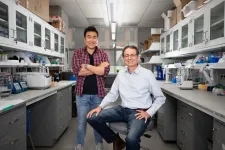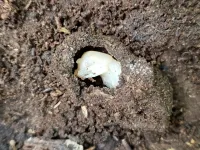(Press-News.org) LEXINGTON, Ky. (May 26, 2021) - Using novel imaging methods for studying brain metabolism, University of Kentucky researchers have identified the reservoir for a necessary sugar in the brain. Glycogen serves as a storage depot for the sugar glucose. The laboratories of Ramon Sun, Ph.D., assistant professor of neuroscience, Markey Cancer Center at the University of Kentucky College of Medicine, and Matthew Gentry, Ph.D., professor of molecular and cellular biochemistry and director of the Lafora Epilepsy Cure Initiative at the University of Kentucky College of Medicine discovered that glucose - the sugar used for cellular energy production - was not the only sugar contained in glycogen in the brain. Brain glycogen also contained another sugar called glucosamine. The full study was recently published in Cell Metabolism.
Some forms of glucosamine, such as glucosamine sulfate and glucosamine hydrochloride, are common supplements used to improve joint movement. However, within cells, glucosamine is an essential sugar needed for the complex carbohydrate chains that are attached to proteins in a process called glycosylation. These sugar chains decorate proteins and the sugar decorations are critical for the appropriate function of myriad proteins.
Discovering that glucosamine is a major component of brain glycogen provides key insight into neurological diseases caused by aberrant glycogen-like cellular aggregates called polyglucosan bodies (PGBs). Lafora disease is a rare, inherited childhood dementia caused by PGBs and this study demonstrates that the Lafora disease PGBs sequester glucosamine, leading to numerous cellular perturbations. PGBs also accumulate in the brain as people age and in people with other forms of dementia. Thus, the discovery that glycogen is also a storage cache for glucosamine has broad implications for understanding neurological changes associated with aging.
Using biochemical approaches, the researchers determined the sugar composition of glycogen in the muscle, liver, and brain of mice. Unlike muscle glycogen, which had only 1% glucosamine, and liver glycogen, which had less than 1% glucosamine, brain glycogen contained 25% glucosamine. "The discovery that brain glycogen is comprised of 25% glucosamine was stunning," stated Sun.
Upon making this surprising discovery, they then identified the enzymes responsible for incorporating glucosamine into glycogen and for releasing glucosamine from glycogen. Again, the discovery was unexpected as these enzymes are the same ones used to incorporate glucose into and release glucose from glycogen.
To understand the implications of their findings for Lafora disease and neurological problems arising from PGBs, the researchers used their newly developed technique called matrix-assisted laser desorption/ionization traveling-wave ion-mobility high-resolution mass spectrometry (MALDI TW IMS) to measure and visualize the amount of glycogen in different regions of the brain. They also used this technique to quantify changes in the specific patterns of the sugar decorations on proteins in multiple regions of the brain.
The team applied MALDI TW IMS to analyze the brains of healthy mice and of two different mouse models of glycogen storage diseases: a model of Lafora disease and a model of glucose storage disease (GSD) type III. Sun commented, "This new technique allows us to quantify the amount of these sugars with high accuracy while also maintaining the spatial distribution within the brain regarding where the sugars are located. It is crucial that the brain has the correct sugars in the right location within the brain."
These studies revealed that without the ability to properly regulate brain glycogen metabolism, not only do PGBs form, which perturbs cell metabolism, but the sugar decoration of proteins is also altered. Excitingly, they could restore protein sugar decoration by injecting an antibody-enzyme fusion (VAL-0417) into the brains of Lafora disease mice to degrade the PGBs. Their findings show a direct connection between abnormal glycogen storage and defective protein function in the brain. Their findings have implications for many other GSDs and congenital disorders of glycosylation, which cause severe neurological symptoms, including epilepsy and dementia.
"Multiple neurological diseases have blockades in these metabolic pathways. I'm sure these pathways are going to be important in other neuro-centric diseases as well. Brain glycogen is comprised of glucose and glucosamine and brain metabolism has to balance both in order to stay healthy," explained Gentry.
The Gentry and Sun laboratories collaborated with several others from UK College of Medicine including Drs. Craig Vander Kooi, professor of molecular and cellular biochemistry, Charles Waechter, professor of molecular and cellular biochemistry, Lance Johnson, assistant professor of physiology, Christine Brainson, assistant professor of toxicology and cancer biology. They also worked with researchers from Indiana University School of Medicine including Drs. Anna A. DePaoli-Roach, professor of biochemistry and molecular biology, Peter J. Roach, professor of biochemistry and molecular biology, Thomas D. Hurley, professor of biochemistry and molecular biology. Richard Taylor, professor of chemistry and biochemistry, from the University of Notre Dame, and Richard Drake, professor of cell and molecular pharmacology and experimental therapeutics from the Medical University of South Carolina, also contributed to this work.
"This type of transdisciplinary collaborative research takes place at UK because of strong leadership from College of Medicine Dean Robert DiPaola, Dr. Mark Evers, Vice President for Research Lisa Cassis, Ph.D. and others," stated Sun.
INFORMATION:
Research reported in this publication was supported by the National Institute of Neurological Disorders and Stroke of the National Institutes of Health under Award Numbers R35NS116824 and P01NS097197, the National Institute on Aging of the National Institutes of Health under Award Number R01AG066653 and R01AG062550, the National Institute of Diabetes and Digestive and Kidney Diseases of the National Institutes of Health under Award Number R01DK27221, and the National Cancer Institute of the National Institutes of Health under Award Number P30CA177558. The content is solely the responsibility of the authors and does not necessarily represent the official views of the National Institutes of Health. This research was also supported by St Baldrick's Career Development Award, V-Scholar Grant, Rally Foundation Independent Investigator grant, and the University of Notre Dame Reisenauer Family GSD Research Fund.
Berkeley -- The lifestyle of the horned passalus beetle, commonly known as the bessbug or betsy beetle, might seem downright disgusting to the average human: Not only does this shiny black beetle eat its own poop, known as frass, but it uses its feces to line the walls of its living space and to help build protective chambers around its developing young.
Gross as it may seem, a new study suggests that this beetle's frass habits are actually part of a clever strategy for protecting the insect's health -- and could help inform human medicine, too.
Researchers at the University of California, Berkeley, have discovered that the frass of the horned passalus beetle is teeming with antibiotic and antifungal chemicals similar to the ones that humans use to ward off bacterial and ...
In a new study published online in spring 2021 and in the July issue of the journal Contraception, University of Chicago Medicine investigators and colleagues interviewed primary care providers in Illinois about their interest in providing medication abortion care and found that lifting FDA restrictions on mifepristone to allow pharmacy dispensing could normalize medication abortion, facilitate its use in primary care facilities, and address disparities in reproductive health access.
"Mifepristone is used in combination with misoprostol to end early pregnancies, during the first trimester," ...
COLUMBUS, Ohio - Thermoelectric power generators that make electrical power from waste heat would be a useful tool to reduce greenhouse gas emissions if it weren't for a most vexing problem: the need to make electrical contacts to their hot side, which is often just too hot for materials that can generate a current.
The heat causes devices to fail over time.
Devices known as transverse thermoelectrics avoid this problem by producing a current that runs perpendicular to the conducting device, requiring contacts only on the cold end of the generator. Though considered a promising ...
DURHAM, N.H.--Researchers at the University of New Hampshire have conducted two of the first studies in New England to collectively show that toxic man-made chemicals called PFAS (per-and polyfluoroalkyl substances), found in everything from rugs to product packaging, end up in the environment differently after being processed through wastewater treatment facilities--making it more challenging to set acceptable screening levels.
"PFAS are persistent substances that are not easily broken down and have been linked to adverse health effects," said Paula Mouser, associate professor of civil and environmental engineering. "They are found in a wide variety of industrial, commercial and medicinal products and can end up in the body, human waste and the environment. If not managed correctly, they ...
In a new study, scientists at The Hong Kong University of Science and Technology (HKUST) have revealed that most T cell epitopes known to be targeted upon natural infection are seemingly unaffected by current SARS-CoV-2 variants.
In their latest research, the team compiled and analysed data from 18 immunological studies of T cell responses involving over 850 recovered COVID-19 patients from across four continents who are well-distributed in age, gender, disease severity and blood collection time. They demonstrated that T cells in these patients targeted fragments (epitopes) of almost all of ...
Rough night of sleep? Relying on caffeine to get you through the day isn't always the answer, says a new study from Michigan State University.
Researchers from MSU's Sleep and Learning Lab, led by psychology associate professor Kimberly Fenn, assessed how effective caffeine was in counteracting the negative effects of sleep deprivation on cognition. As it turns out, caffeine can only get you so far.
The study -- published in the most recent edition of Journal of Experimental Psychology: Learning, Memory, & Cognition -- assessed the impact of caffeine after a night of sleep deprivation. More than 275 participants were asked to complete a ...
Reverse transcription-polymerase chain reaction (RT-PCR) has been the gold standard for diagnosis during the COVID-19 pandemic. However, the PCR portion of the test requires bulky, expensive machines and takes about an hour to complete, making it difficult to quickly diagnose someone at a testing site. Now, researchers reporting in ACS Nano have developed a plasmofluidic chip that can perform PCR in only about 8 minutes, which could speed diagnosis during current and future pandemics.
Rapid diagnosis of COVID-19 and other highly contagious viral diseases is important for timely medical care, quarantining ...
Adults with schizophrenia have an elevated risk of dying from suicide. Yet there's only limited understanding of when and why people with schizophrenia die of suicide --in part because research studies have looked at relatively small groups of patients.
Now a new study from Columbia that looked at a large population of adults diagnosed with schizophrenia has found the youngest group (18-34) had the highest suicide risk and those aged 65 and older had the lowest. By comparison, in the general U.S. population, younger adults have less risk and older age groups have greater risk.
The Columbia study, published online May 26 in the journal JAMA Psychiatry, (LINK TK) also showed that people with schizophrenia, overall, have a 4.5-fold increased risk of dying from suicide, ...
When enjoying a chocolate bar, most people don't think about how the molecules within it are organized. But different arrangements of the fats in chocolate can influence its taste and texture. Now, researchers reporting in ACS' Crystal Growth & Design have found that the side of a chocolate bar facing the mold has a more orderly crystalline structure than the side facing air, knowledge that might help chocolatiers produce tastier confections, the researchers say.
Chocolate is a mixture of cocoa solids, cocoa butter, sugar and other ingredients that interact with each other in complex ways. In particular, the fat molecules, or triacylglycerols, can remain liquid or crystallize into several phases with different melting points. ...
Several indicators point to the adverse impacts of climate change on the planet’s vegetation, but a little-known positive fact is the existence of climate-change refugia in which trees are far less affected by the gradual rise in temperatures and changing rainfall regimes. Climate-change refugia are areas that are relatively buffered from climate change, such as wetlands, land bordering water courses, rocky outcrops, and valleys with cold-air pools or inversions, for example.
A study conducted in Peruaçu Caves National Park in the state of Minas Gerais, Brazil, with FAPESP’s support, confirmed and quantified ...





